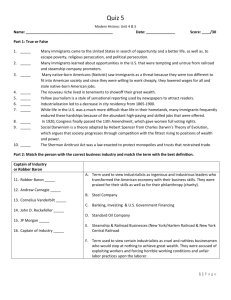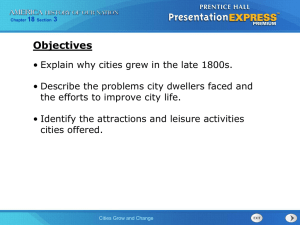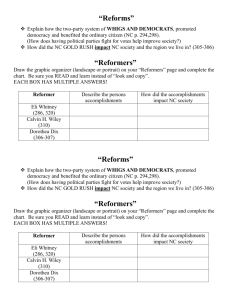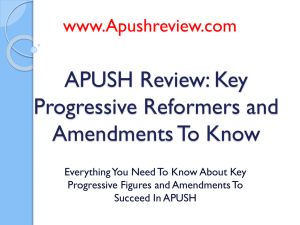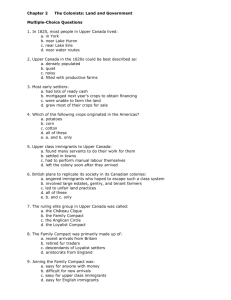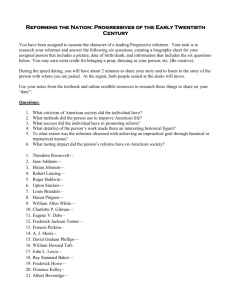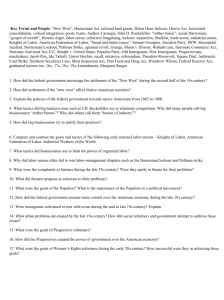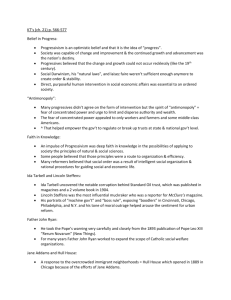Chapter 19 - School Webmasters
advertisement
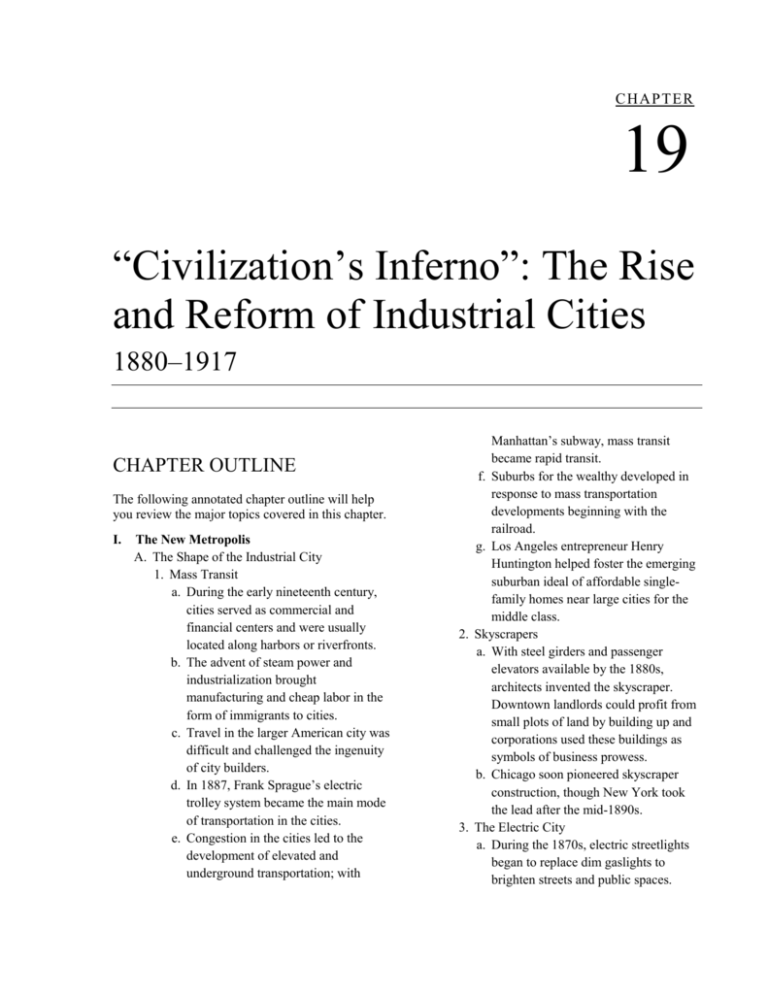
C HAP TER 19 “Civilization’s Inferno”: The Rise and Reform of Industrial Cities 1880–1917 CHAPTER OUTLINE The following annotated chapter outline will help you review the major topics covered in this chapter. I. The New Metropolis A. The Shape of the Industrial City 1. Mass Transit a. During the early nineteenth century, cities served as commercial and financial centers and were usually located along harbors or riverfronts. b. The advent of steam power and industrialization brought manufacturing and cheap labor in the form of immigrants to cities. c. Travel in the larger American city was difficult and challenged the ingenuity of city builders. d. In 1887, Frank Sprague’s electric trolley system became the main mode of transportation in the cities. e. Congestion in the cities led to the development of elevated and underground transportation; with Manhattan’s subway, mass transit became rapid transit. f. Suburbs for the wealthy developed in response to mass transportation developments beginning with the railroad. g. Los Angeles entrepreneur Henry Huntington helped foster the emerging suburban ideal of affordable singlefamily homes near large cities for the middle class. 2. Skyscrapers a. With steel girders and passenger elevators available by the 1880s, architects invented the skyscraper. Downtown landlords could profit from small plots of land by building up and corporations used these buildings as symbols of business prowess. b. Chicago soon pioneered skyscraper construction, though New York took the lead after the mid-1890s. 3. The Electric City a. During the 1870s, electric streetlights began to replace dim gaslights to brighten streets and public spaces. C HAPTER 19 • “C IVILIZATION ’ S I NFERNO ”: T HE R ISE AND R EFORM OF I NDUSTRIAL C ITIES b. Electric light gave the city its modern tempo, turned night into day, improved safety, and made nightlife more appealing. B. Newcomers and Neighborhoods 1. Young men and women from rural areas looking for work and hoping to help families back home moved to cities and contributed to their explosive growth. 2. Cities also became homes for millions of immigrants from overseas. The biggest ethnic group in Boston was the Irish; in Minneapolis, Swedes; in most other northern cities, Germans. Arriving in the metropolis, immigrants confronted many difficulties, and most relied on relatives and friends to get oriented and find employment. 3. Patterns of settlement varied by ethnic group. Many Italians, recruited by padroni, or labor bosses, found work in northeastern and Mid-Atlantic cities. Their urban concentration was especially marked after the 1880s, as more and more immigrants—especially men—arrived from southern Italy. 4. Institutions of many kinds, including newspapers and mutual aid societies, sprang up to serve the social and economic needs of ethnic urban communities. 5. Sharply defined ethnic neighborhoods— such as San Francisco’s Chinatown, Italian North Beach, and Jewish Hayes Valley—grew up in every major city, driven by discrimination, immigrants’ desire to stick together, and class divisions. 6. A great African American migration from the rural South to southern and northern cities began at the turn of the century, but urban blacks could not escape discrimination; job opportunities were few and usually limited to the service sector. 7. Race riots periodically plagued the black urban community in both northern and southern cities, often targeting black business districts. 8. Whether they arrived from the rural South or from Europe, Mexico, or Asia, working-class city residents needed cheap housing near their jobs. 9. As urban land values climbed, speculators tore down older houses that had been vacated by middle-class families moving to the suburbs. In their place, they erected five- or six-story tenements, buildings that housed twenty or more families in cramped, airless apartments. 10. Although reformers were able to convince municipal governments to establish housing codes requiring indoor toilets and fire safeguards, these laws did not apply to the thousands of tenements already in existence. C. City Cultures 1. Urban Amusements a. Despite their many dangers and problems, industrial cities could also be exciting places to live—places where people could challenge older mores. b. By the turn of the twentieth century, new mass-based entertainments had emerged among the working classes, especially youth. c. At the same time, the great cities proved to be stimulating centers for intellectual life, from museums and opera houses to news magazines. d. One enticing attraction for city dwellers was the vaudeville theater, which arose in the 1880s and 1890s. Customers could walk in any time and watch a continuous sequence of musical acts, skits, juggling, magic, and other entertainment. e. By the 1910s, movie theaters became respectable places for amusement. f. Even more spectacular were great amusement parks that appeared around 1900, most famously at New York’s C HAPTER 19 • “C IVILIZATION ’ S I NFERNO ”: T HE R ISE AND R EFORM OF I NDUSTRIAL C ITIES Coney Island. These parks had their origins in world’s fairs, whose free educational exhibits proved less popular than their paid entertainment areas. 2. Ragtime and City Blues a. Popular music also became a booming business in the industrial city. By the 1890s, Tin Pan Alley, the nickname for New York City’s song-publishing district, produced dozens of such national hit tunes as “A Bicycle Built for Two” and “My Wild Irish Rose.” b. African American artists brought a syncopated beat that, by the 1890s, began to work its way into mainstream hits like “A Hot Time in the Old Town Tonight.” Black performers soon became stars in their own right with the rise of ragtime. The exciting “ragged rhythm” became wildly popular across class and race lines, as it differed from Victorian hymns and parlor songs. c. Scott Joplin, a master of the genre, hoped to elevate African American music and secure a broad nation audience. He introduced ragtime to national audiences at the Chicago World’s Fair in 1893. d. Ragtime ushered in an urban dance craze. Despite widespread condemnation of the sexual nature of dances such as the Bunny Hug and Grizzly Bear, the dance mania spread from urban working classes to rural and middle-class youth. e. By the 1910s, black music entered mainstream popular culture. For example, Blues music appealed to young urbanites, who were far from home experiencing loneliness, dislocation, and disappointment along with the thrills of city life. f. Ragtime and Blues profoundly influenced twentieth-century American culture as the commercial music industry and youth brazenly appropriated black musical styles as their own. 3. Sex and the City a. In the city, where parental oversight was weaker than it had been in previous generations, amusement parks and dance halls helped young people foster the new custom of dating, which like many other cultural innovations emerged first among the working class. b. Gradually, it became more acceptable for a young man to escort a young woman out on the town for commercial entertainments, rather than spending the evening at home under parents’ watchful eyes. For young people, dating opened a new world of pleasure, sexual adventure, and danger. c. Young women proved most vulnerable in the system of dating. Although many tried to maintain strict standards of respectability, the lines between working-class “treats” and casual prostitution often blurred. d. Dating and casual sex were hallmarks of an urban world in which large numbers of residents were young and single. e. In addition to informal and casual heterosexual relationships, many industrial cities developed robust gay subcultures. A gay world flourished in New York, for example, including an array of drinking and meeting places, as well as underground gay clubs and drag balls. C HAPTER 19 • “C IVILIZATION ’ S I NFERNO ”: T HE R ISE AND R EFORM OF I NDUSTRIAL C ITIES 4. High Culture a. For elites, the rise of great cities offered an opportunity to build museums, libraries, and other cultural institutions that could flourish only in major metropolitan centers. Millionaires patronized the arts partly to advance themselves socially but also out of a sense of civic duty and national pride. b. Art museums, history museums, and public libraries grew into major urban institutions. 5. Urban Journalism a. Publishers such as Joseph Pulitzer and William Randolph Hearst established mass-market newspaper empires by printing sensational investigations of scandals and injustices. The arrival of Sunday color comics, like R. F. Outcault’s “The Yellow Kid” (1894), lent their name to “yellow journalism,” a derogatory term used for these papers. b. By 1900, new magazines such as Collier’s and McClure’s introduced middle-class readers to the work of such reporters as Ida Tarbell, who exposed the machinations of John D. Rockefeller, and David Graham Phillips, whose “Treason of the Senate,” published in Cosmopolitan in 1906, documented the deference of U.S. senators—especially Republicans—to wealthy corporate interests. c. President Roosevelt dismissed exposé journalists as muckrakers who focused too much on the negative side of American life. But they inspired thousands of readers to get involved in reform movements and tackle the problems caused by industrialization. II. Governing the Great City A. Urban Machines 1. As industrial cities grew with breathtaking speed, their governance posed a serious problem. 2. In the United States, cities relied largely on private developers to build streetcar lines and provide urgently needed water, gas, and electricity. This preference for business solutions gave birth to what one urban historian calls the “private city”—a place shaped by individuals and profitseeking businesses. 3. Urban political machines served as a social service agency for city dwellers, providing jobs, lending help, and interceding against the city bureaucracy. 4. In New York, ward boss George Washington Plunkitt integrated private business and political services. 5. For city businesses, the machine served a similar purpose, but it exacted a price in return for its favors: tenement dwellers gave a vote and businesses wrote a check. 6. In the 1860s, boss William Marcy Tweed had made Tammany Hall a byword for corruption, until his extravagant graft in the building of a lavish city courthouse led to his arrest in 1871 and a decline thereafter in the more blatant forms of machine corruption. 7. George Washington Plunkitt declared that he favored “honest graft,” the easy profits that came to savvy insiders. 8. Middle-class reformers who condemned immigrants for supporting city machines did not realize that, for immigrants, the corrupt system meant jobs, emergency aid, and the only public service they could hope to attain. 9. Machine-style governments accomplished some notable successes, such as build sewage systems, bridges, spacious parks, and major sanitation projects. C HAPTER 19 • “C IVILIZATION ’ S I NFERNO ”: T HE R ISE AND R EFORM OF I NDUSTRIAL C ITIES 10. These achievements were remarkable because American city governments labored under severe political constraints. 11. As cities continued to expand, the limits of machine government became increasingly clear. In addition to the problem of corruption, even the hardestworking ward boss could only help individuals on a local level, in limited ways. Most improvements followed the money into the affluent neighborhoods. B. The Limits of Machine Government 1. Even a casual observer could see that cities were finding it difficult to cope with extremely rapid growth and that some urban politicians preferred personal gain to public welfare. 2. The problems that resulted were dramatically evident during the depression of the 1890s, when working-class unemployment reached a staggering 25 percent in some cities, and homelessness and hunger were rampant. 3. The crisis of the 1890s radicalized many urban voters, who proved none too loyal to the machines when better alternatives arose. 4. Middle-class reformers launched ambitious improvement programs. Some advocated municipal ownership of utilities. Others built public baths, gyms, swimming pools, and playgrounds. Most mayors battled with corrupt streetcar companies to bring down fares and introduce competition. 5. Reformers slowly defeated machinesupported candidates by promising reduction in crime, affordable housing, and more funding for schools. 6. Reformers also experimented with new ways of organizing municipal government. After a devastating hurricane in 1900 killed an estimated six thousand people in Galveston, Texas, and destroyed much of the city, rebuilders adopted a commission system that became a nationwide model for efficient government. Several cities adopted the referendum system, allowing voters to express their opinion on key political questions. III. Crucibles of Progressive Reform A. Fighting Dirt and Vice 1. Cleaning Up Urban Environments a. Progressivism, the overlapping movements by working-class radicals and middle-class reformers to combat the ills of industrialization, had roots in the city. b. News reporters such as Helen Campbell and Jacob Riis used the recently invented flash photography to expose the problems of poverty, disease, and crime in the tenements. c. One of the most urgent problems of the big city was disease. In the late nineteenth century, researchers in Europe came to understand the role of germs and bacteria. American city leaders adopted more municipal cleanwater, sewage, and drainage projects. d. The public health movement became one of the era’s most visible and influential reforms. e. In cities, the impact of pollution was more obvious than in rural areas. Children played on piles of garbage, breathed toxic air, and consumed poisoned food, milk, and water. Infant mortality rates were shocking. f. Outraged, urban reformers mobilized to demand safe water and better garbage collection. Hygiene reformers taught hand-washing and other techniques to fight the spread of tuberculosis. g. Reformers also urged the adoption of smoke-abatement laws and launched the “City Beautiful” movement that aimed to make industrial cities healthier and nicer places. C HAPTER 19 • “C IVILIZATION ’ S I NFERNO ”: T HE R ISE AND R EFORM OF I NDUSTRIAL C ITIES 2. Closing Red Light Districts a. Distressed by the commercialization of sex in American cities, reformers also launched a nationwide campaign against prostitution; they warned of the threat of “white slavery,” alleging (in spite of considerable evidence to the contrary) that young white women were being kidnapped and forced into prostitution. b. Practical investigators found a more complex reality: women entered prostitution as a result of many factors, including low-wage jobs, economic desperation, and often sexual and domestic abuse. c. A wave of brothel closings crested between 1909 and 1912, as police shut down red light districts in cities nationwide. Meanwhile, Congress passed the Mann Act (1910) to prohibit the transportation of prostitutes across state lines. d. The crusade against prostitution accomplished its main goal—closing brothels—but in the long term it worsened the conditions under which many prostitutes worked. B. The Movement for Social Settlements 1. Urban reformers, focused on the plight of the urban poor, developed a far more ambitious project: the social settlement. The most famous of these was Hull House on Chicago’s West Side, founded in 1889 by Jane Addams and Ellen Gates Starr. 2. The project was an idea borrowed not only from American urban missions but also from Toynbee Hall, a London settlement that they had visited while touring Europe. 3. Addams envisioned Hull House as a link between the middle and working classes, where both learned about each other and shared what each could offer. 4. Addams and her colleagues came to believe that immigrants already knew what they needed. What they lacked were the resources to fulfill those needs, as well as a strong political voice. Hull House was typical in offering a bathhouse, playground, kindergarten, and day care. 5. By the early twentieth century, social settlements sprang up all over the United States. They engaged in an array of public activities and took many forms. Some attached themselves to pre-existing missions or to African-American colleges. Others were founded by energetic graduates of women’s colleges. 6. Social settlements used their resources and influence in many ways. They opened libraries and gymnasiums for working men and women. They operated employment bureaus, penny savings banks, and cooperative kitchens for tired families. 7. Settlement work served as a springboard for other projects, such as school reform, workplace safety laws, lead poisoning, and juvenile delinquency. 8. Margaret Sanger, a nurse who volunteered with a Lower East Side settlement, was horrified by women’s suffering from constant pregnancies and launched a national birth control movement. 9. Settlement work was an early, crucial proving ground for the emerging profession of social work, which transformed the provision of public welfare. 10. Social workers rejected the older model of private Christian charity, dispensed by well-meaning middle-class people to those in need. Instead, they used the new social sciences to gather facts and advocate change. C. Cities and National Politics 1. Despite the work of reformers, the problems of the industrial city grew more rapidly than remedies for them could be found. Journalist Upton Sinclair published his novel The Jungle, an exposé of labor exploitation in Chicago meat-packing C HAPTER 19 • “C IVILIZATION ’ S I NFERNO ”: T HE R ISE AND R EFORM OF I NDUSTRIAL C ITIES 2. 3. 4. 5. 6. 7. 8. plants. His descriptions of rotten meat and filthy conditions caught the nation’s attention. Congress passed the Pure Food and Drug Act (1906) and created the Food and Drug Administration to oversee compliance with the new law. Urban reformers began to realize they could affect national politics. The National Consumers’ League, encouraging shoppers to patronize only stores where wages and working conditions were fair, became one of the most powerful progressive organizations advocating worker protection laws. Many labor organizations, such as the Women’s Trade Union League, grew to national stature. Trade-union women and their wealthy allies also joined together in the broader struggle for women’s rights. The need for state and national action became clear by the Triangle Shirtwaist Fire in 1911 that lead to the death of 146 garment workers, mostly young immigrant women. Shock, anger, and grief crossed ethnic, class, and religious boundaries. New York State developed a labor code that established sweeping fire, safety, wage, and working hour regulations. The tragedy demonstrated that the social and economic problems of the industrial city had outgrown the power of the political machines; only stronger state and national laws could affect serious change. The political aftermath of the Triangle fire showed how challenges posed by industrial cities pushed politics in new directions, not only by transforming urban government but also by helping to build broader movements for reform. By 1900, Americans and new immigrants, who had thronged to the great cities from rural areas and from countries around the world, helped build America into a global industrial power. In the process, they created an electorate and a society that was far more ethnically, racially, and religiously diverse than it had been before.
